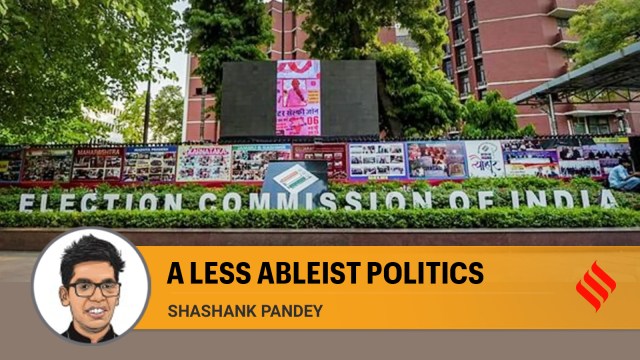
On December 21, the Election Commission of India released an advisory for political parties to follow disability-sensitive terminologies. The 11 guidelines can broadly be put into three categories: Disability-inclusive communication by political parties and their members, accessibility of information and inclusion within party frameworks. The guidelines on communication relate to the usage of ill-health terminologies for persons with disabilities (PwD), dehumanising or using PwDs to depict incapacity or perpetuate stereotypes. The guidelines around accessibility relate to information accessibility on political party websites and holding events at accessible places. The third head provides for the development of training modules on disability for party workers and endeavours to include PwDs at all levels of a political party.
Recent instances have underlined the need for these guidelines. For example, in September 2023, Tamil Nadu leader A Raja compared Sanatan Dharma to people with leprosy and HIV in a derogatory manner. National leaders have also used disability in a demeaning manner, especially during election speeches. Such instances dehumanise PwDs and perpetuate stereotypes, resulting in an “attitudinal barrier” under the Rights of Persons with Disabilities Act, 2016.
Political inclusion is an ignored aspect within the Indian realm of disability. Although these guidelines are a reformative step in that direction, an effective strategy is still required.
First, these guidelines are only an “advisory”, though the phraseology of a few guidelines is in mandatory language. For instance, guidelines under the disability-inclusive communication head use words like “should” and “shall” before and after the instructions. However, other guidelines, especially under the inclusion within the political party framework, are still incorporated in discretionary terms, for example, using “may.” A uniform mandate under all three heads is needed.
Second, it is understood that these guidelines are still not part of the Model Code of Conduct. The advisory mentions that the breach of guidelines related to disability-inclusive communication would make political parties and their members prone to action under section 92 of the RPwD Act. It’s unclear whether a breach of other guidelines will also invoke this provision. Section 92 is a punishment provision for atrocities against PwDs. These guidelines must be given teeth by including them within the MCC on the lines of gender guidelines.
Third, there is some ambiguity within the guidelines with respect to the usage of specific phraseology. For instance, it cites words like “blind”, “deaf” and “dumb” as examples of wrong terminologies. Although their translation in Hindi or another language might be derogatory, these are technical words to refer to people with visual, hearing, and speech disability. A detailed list of disability-sensitive words and phraseology under the UN Disability Inclusion Strategy can guide the ECI.
Fourth, the draft National Policy for PwD released last year for public consultation didn’t have any chapter on political inclusion. The ECI advisory says that “political parties must endeavour to include PwD at all levels as members and party workers”. It also prescribes adherence to accessibility norms by political parties, which are the first instance of access to political space for PwD. As these guidelines are expected to catalyze the political inclusion of PwD, a chapter on political inclusion in the national policy should be incorporated. This will align with the principles of Article 29 of the UN Convention on the Rights of Persons with Disabilities.
Lastly, we still have no data on the number of legislators with disabilities. The ECI still doesn’t have any column on disability in the nomination forms and affidavits filed by contestants during elections. The lack of data has contributed significantly to the political exclusion of PwDs. It is hoped that the ECI will also correct this anomaly. The 2024 elections are an opportunity to address this lack. It can be the second step towards the political inclusion of PwD.
The writer is a lawyer and policy consultant on disability law. He is also a founder of the Politics and Disability Forum.